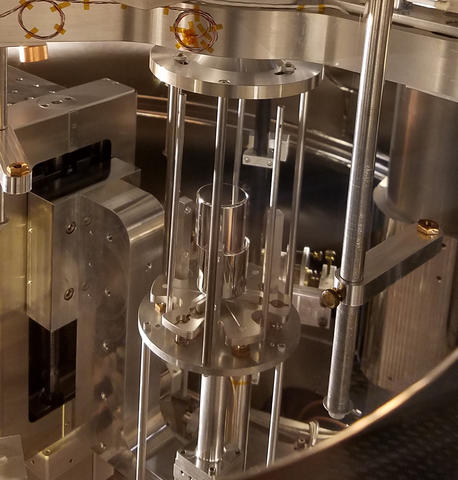Will the Kilogram mass unit be redefined in 2018?
The calculation of a kilogram will be changed by using the Planck constant.
- Concussion conclusions: In addition to 3 solid, liquid, water gas, there is a fourth state
- Physicists create matter with "negative mass"
Recently, the National Institute of Standards and Technology - NIST has found the most accurate value of this Planck constant. This enables the Science and Technology Data Commission to give an accurate definition of 'one kilogram' in 2018.

Prototype International Kilogram.
Specifically, NIST introduced the new Planck constant value of 6.626069934 x 10 −34 kg ∙ m2 / s, replacing the old value of 6.62607004 x 10 1034 kg.m2 / s.
Scientists used the 'Kibble balance' Kibble balance machine to calculate the new value of the Planck constant with a deviation of only 13 / 1,000,000,000, more accurately than the previous one with a deviation of 34 / 1,000. .000,000.
So what is Planck's constant?
This constant is taken from the German physicist Max Planck, who seeded quantum theory about a century ago. Quantum physics is often used to calculate the energy level of particles and objects.

Max Planck - German physicist.
Planck has discovered that energy transfer always follows a certain amount. By measuring the amount of heat radiation emitted when the atoms in matter vibrate, he determines the frequency of the waves produced by this phenomenon will be the number of times a constant is called h. We have h, 2h or 3h but never half h - h is the amount of energy we have said above.
That unit h is named Planck constant. If we take the Planck constant multiplied by the frequency of a wave, we can find energy in that wave. Thanks to Einstein we know that energy and mass always come together so we can get Planck's constant to describe the mass of an object.
Up to this point, only the kilogram unit is defined by a specific object. It is the International Prototype Kilogram (IPK) Prototype or 'Le Grand K', a round cylindrical solid block of 39 mm diameter, 39 mm high, 90% platinum and 10% iridium, in a safe in France.
Over a long period of time, the mass of this standard kilogram is no longer exactly the same as the atom could fall, but it could also be added. Therefore, we cannot use IPK as a standard measurement for a kilogram.
In addition, there is another reason that using IPK as a standard for a kilogram is already obsolete. All other physical quantities have had mathematical constants for definition.
- Ampere will be defined by the fundamental charge, ie the charge of the electron and photon.
- Kelvin will be defined by the Boltzmann constant.
- Mole will be defined by Avagadro constant.

Le Grand K. - Le Grand K.
We can take the specific atomic number of an element to give a definition of a kilogram to a norm. And that is Planck's constant.
The Kibble balancing device consists of a heavy weight placed on a core-mounted rack mounted in a magnetic field. When power is applied to this core, an electric current creates another magnetic field that pushes the mass of the weight. Scientists will use special operations to measure the current and measure the movement of the stand when there is and no weight to produce the Planck constant.

Kibble balance device.
Stephan Schlamminger, the head of the study, said they had three trials with a deviation of less than 20 parts per billion, while at least three trials with a deviation of less than 50 parts per billion and one deviation below 20 parts 1 billion to determine the correct number
Scientists at NIST hope that, with these newer and more accurate numbers, the new meaning of 1 kilogram will be approved and recognized by the community next November.
You should read it
- Half a meter long mouse that can bite the coconut for the first time was discovered after 80 years
- Constants in PHP
- 15 great physicists change the way we understand the world
- Constant in programming C
- It's time to change the definition of hackers
- Harmful myths when adjusting the TV definition
- Preprocessor in C ++
- Hackers track iPhone prototypes to exploit vulnerabilities
May be interested
- China has 'weighed' the mass of light
 a research team from sichuan university of science & technology, chinese academy of sciences and nanjing university recently weighed the mass of light.
a research team from sichuan university of science & technology, chinese academy of sciences and nanjing university recently weighed the mass of light. - How to use a hidden unit converter in Microsoft Word
 did you know that word 2016 can convert from one measurement unit to another with just one click? microsoft office calls them built-in actions and it is hidden inside word options.
did you know that word 2016 can convert from one measurement unit to another with just one click? microsoft office calls them built-in actions and it is hidden inside word options. - What is MTU?
 the maxium transmission unit (mtu) is the largest data packet size, measured in bytes, that can be transmitted over a network.
the maxium transmission unit (mtu) is the largest data packet size, measured in bytes, that can be transmitted over a network. - How does DNA identify victims in mass disasters?
 dna analysis is considered the gold standard for identifying victims in mass shootings. but how does dna identify victims in mass murder?
dna analysis is considered the gold standard for identifying victims in mass shootings. but how does dna identify victims in mass murder? - How many inches is 1 inch?
 although not popular in vietnam, inch units are also much related to the work and study of many people, so knowing 1 inch by how many centimeters, mm, m and other length measurement units will help them we can easily get more information.
although not popular in vietnam, inch units are also much related to the work and study of many people, so knowing 1 inch by how many centimeters, mm, m and other length measurement units will help them we can easily get more information. - Change the measurement unit in Word 2007 2010 2013
 the demand for using word in the drafting is quite large, you want to use for different purposes, and want to use the measurement unit in word, you need to know how to change the measurement unit in word to suit your needs. mine.
the demand for using word in the drafting is quite large, you want to use for different purposes, and want to use the measurement unit in word, you need to know how to change the measurement unit in word to suit your needs. mine. - Learn about Decibel (dB) in computer networks
 decibel (db) is a standard measurement unit, used to measure the strength of wired and wireless network signals.
decibel (db) is a standard measurement unit, used to measure the strength of wired and wireless network signals. - Hot air conditioner is loud, cause and treatment
 if you are also having trouble like that, please refer to the content below to proactively overcome the phenomenon of the outdoor unit shouting and shaking vigorously.
if you are also having trouble like that, please refer to the content below to proactively overcome the phenomenon of the outdoor unit shouting and shaking vigorously. - How to send bulk emails on Apple Mail
 one of the fastest ways for you to email a group on your iphone is to create a contact with an email group that you email regularly, such as a business exchange.
one of the fastest ways for you to email a group on your iphone is to create a contact with an email group that you email regularly, such as a business exchange. - What is a cyclone? Common errors in cyclones
 air conditioner is a very important part of the air conditioner, helping to ensure the process of transporting gas from the indoor unit to a liquid form into a stable outdoor unit.
air conditioner is a very important part of the air conditioner, helping to ensure the process of transporting gas from the indoor unit to a liquid form into a stable outdoor unit.










 Why is ice water white and pelleted?
Why is ice water white and pelleted? Blushing after drinking alcohol, the hidden sign of a dangerous disease many people don't expect
Blushing after drinking alcohol, the hidden sign of a dangerous disease many people don't expect What caused the ball to float on such a jet?
What caused the ball to float on such a jet? Marvel at the destructive weapons produced by Samsung that you never knew
Marvel at the destructive weapons produced by Samsung that you never knew The dramatic swimming competition of 300 million sperm comes to see eggs under a humorous perspective
The dramatic swimming competition of 300 million sperm comes to see eggs under a humorous perspective Science is still finding the mystery behind 'hole-fear syndrome - trypophobia'
Science is still finding the mystery behind 'hole-fear syndrome - trypophobia'